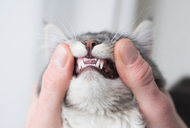Understanding your cat’s teeth
22nd Feb 2024
A cat’s teeth are very important. They use them for eating, playing, self-defence, grooming and hunting. In the wild, a cat without any teeth would sadly not last very long. It is important for us, as cat owners, to understand how best to care for their teeth so they remain happy and healthy.
Cats are diphyodont. This means that they will have two sets of teeth within their lifetime, a baby set and then their permanent set, just like us humans. Kittens are born without any teeth, but they start erupting through the gums when they are around 2-3 weeks old. They will have all 26 deciduous (baby) teeth, consisting of 12 incisors, 4 canines, and 10 pre-molars by the time they reach 8 weeks.
By the time a kitten is about 3-4 months old, the adult teeth will be developing below the gum line. As their adult teeth push through the gums the kitten will lose their baby teeth and by the time they are about 6 months old, they should have all 30 of their adult teeth. Their set of adult teeth will consist of 12 incisors, 4 canines, 10 pre-molars, and 4 molars. A teething kitten may experience some discomfort, so you may notice that they are irritable, pawing at their face, have a reduced appetite, and dribbling. These are all normal signs of teething, but if your kitten is experiencing excessive symptoms, seek veterinary advice in case there is something wrong.
Fully grown cats have 4 types of teeth:
- Incisors are the small teeth at the front of your cat’s mouth. They are used for cutting, picking things up, grooming and playfighting.
- Canines are the large, sharp fangs that sit just behind the incisors at the front of the mouth. They are used during hunting and fighting and can cause real damage. They are very strong and can keep a tight grasp upon the cat’s prey after it has been caught.
- Pre-molars are the wide teeth towards the back of a cat’s mouth. These serrated teeth are used to grasp prey and to chew their food into manageable chunks.
- Molars are the teeth right at the back of a cat’s mouth. They are also used for chewing but are also powerful enough to crunch through hard foods, such as bone.
Cats can suffer from a number of different dental diseases and issues. The most common are tooth resorption, gingivitis, and periodontitis. Signs to look out for include; watering mouth, pawing at the affected area, and/or jaw chattering. The pain may cause your cat discomfort when eating, characterised by slow, considered chewing, dropped food and poor appetite. If these symptoms persist in a non-teething cat, veterinary care will be required.
Ensuring your cat enjoys a species appropriate diet is a natural way of keeping their teeth and gums healthy. It is sometimes thought that dry food helps to clean the teeth and the gums. However, this is not the case as the dry food is prone to getting stuck between the teeth, which can cause the symptoms mentioned above.
In the wild, a cat’s diet would be made up almost exclusively of protein from meat. A solely protein diet will be virtually free of sugars and carbohydrates, two of the biggest contributors to dental disease. Gnawing and chewing on pieces of bone will also help to keep their teeth and gums clean, strong, and healthy.
